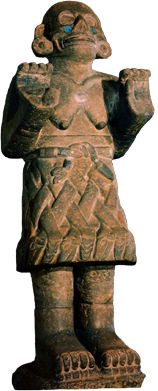|
It used to be thought that the Aztecs were the first Mesomericans to practice idolatry, or image-worship. They were indeed the first Mesoamerican culture with a significant corpus of freestanding stone sculpture as objects of veneration. But Esther Pasztory (Aztec Art, Abrams, New York, 1983) surveys the sculptural tradition of Classic Veracruz and Oaxaca in other media and comes to a different conclusion.
Rather than inventing "idolatry" the Aztecs seem to have translated into stone what previous and neighboring cultures had represented in other media. ... The use of stone as a major medium in sculpture is significantly Aztec, and this preference is related to the late position of the Aztecs in Mesoamerican history. They associated stone with the great civilizations of the past and apparently adopted it even for modest objects because of its connotations of permanence and associations with ancient grandeur. (ibid.:209) Pasztory is able to trace a number of Aztec sculptures to "local schools of carving." A seated image of the God of Flowers is almost certainly in the style of Chalco. The statue of Mictlantecihuatl (above, right) is another story. According to Pasztory:
Other local schools can be defined on the basis of a few, particulary well-made sculptures. Two standing figures, male and female, each over three feet high, come from Coxcatlan in Puebla. Both are intermediate in size between the small works and the great monuments of Tenochtitlan. (ibid.:212) (As an example of one of the latter, see the image of Coatlicue to the right. Note the "snake skirt" common to both images. The name Coatlicue is based on the Nahuatl word for "snake.") Pasztory continues:
It is unfortunate that these sculptures are not dated; it would be interesting to know if they predate or postdate the development of monumental sculpture at Tenochtitlan. The Goddess in Serpent Skirt resembles small death goddess images and also the awesome Coatlicue of Tenochtitlan. The figure is tall and slender, its back hunched; breasts and collarbone are modeled in detail. (ibid.:212) Pasztory's comments on the Coatlicue elsewhere in the same volume are provocative. Noting that the statue could also be identified as the goddess Cihuacoatl (literally "woman-serpent"), Pasztory associates this latter deity with the earth, particularly in its voracious guise.
Besides being an earth goddess, Cihuacoatl had special significance as the patron goddess of Culhuacan, the community with a Toltec-related ruling dynasty through which the rules of Tenochtitlan claimed Toltec descent. Cihuacoatl therefore symbolized the Toltec earth mother of the Mexica, and the name Coatlicue is merely the Mexica variant of Cihuacoatl. The myth of the birth of Huizilopochtli may signify the birth of the Mexica god from the Toltec mother goddess, who dies in parturition. |

Death Goddess in Serpent Skirt. Museo Nacional de Antropología, Mexico City.
Coatlicue. Museo Nacional de Antropología, Mexico City. |
home
